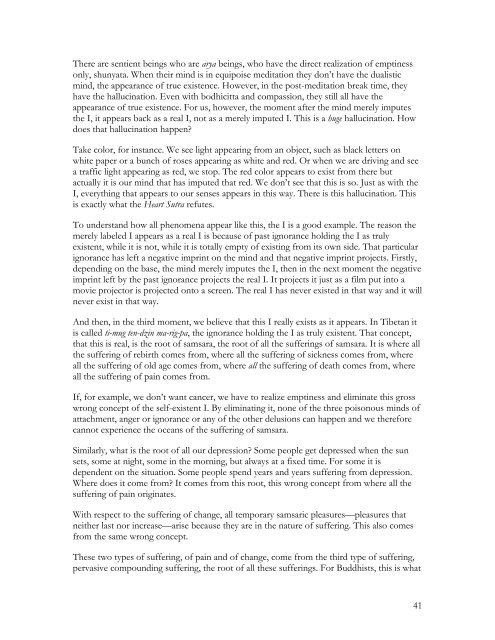Lama Zopa Rinpoche
55OTzl52A
55OTzl52A
You also want an ePaper? Increase the reach of your titles
YUMPU automatically turns print PDFs into web optimized ePapers that Google loves.
There are sentient beings who are arya beings, who have the direct realization of emptiness<br />
only, shunyata. When their mind is in equipoise meditation they don’t have the dualistic<br />
mind, the appearance of true existence. However, in the post-meditation break time, they<br />
have the hallucination. Even with bodhicitta and compassion, they still all have the<br />
appearance of true existence. For us, however, the moment after the mind merely imputes<br />
the I, it appears back as a real I, not as a merely imputed I. This is a huge hallucination. How<br />
does that hallucination happen?<br />
Take color, for instance. We see light appearing from an object, such as black letters on<br />
white paper or a bunch of roses appearing as white and red. Or when we are driving and see<br />
a traffic light appearing as red, we stop. The red color appears to exist from there but<br />
actually it is our mind that has imputed that red. We don’t see that this is so. Just as with the<br />
I, everything that appears to our senses appears in this way. There is this hallucination. This<br />
is exactly what the Heart Sutra refutes.<br />
To understand how all phenomena appear like this, the I is a good example. The reason the<br />
merely labeled I appears as a real I is because of past ignorance holding the I as truly<br />
existent, while it is not, while it is totally empty of existing from its own side. That particular<br />
ignorance has left a negative imprint on the mind and that negative imprint projects. Firstly,<br />
depending on the base, the mind merely imputes the I, then in the next moment the negative<br />
imprint left by the past ignorance projects the real I. It projects it just as a film put into a<br />
movie projector is projected onto a screen. The real I has never existed in that way and it will<br />
never exist in that way.<br />
And then, in the third moment, we believe that this I really exists as it appears. In Tibetan it<br />
is called ti-mug ten-dzin ma-rig-pa, the ignorance holding the I as truly existent. That concept,<br />
that this is real, is the root of samsara, the root of all the sufferings of samsara. It is where all<br />
the suffering of rebirth comes from, where all the suffering of sickness comes from, where<br />
all the suffering of old age comes from, where all the suffering of death comes from, where<br />
all the suffering of pain comes from.<br />
If, for example, we don’t want cancer, we have to realize emptiness and eliminate this gross<br />
wrong concept of the self-existent I. By eliminating it, none of the three poisonous minds of<br />
attachment, anger or ignorance or any of the other delusions can happen and we therefore<br />
cannot experience the oceans of the suffering of samsara.<br />
Similarly, what is the root of all our depression? Some people get depressed when the sun<br />
sets, some at night, some in the morning, but always at a fixed time. For some it is<br />
dependent on the situation. Some people spend years and years suffering from depression.<br />
Where does it come from? It comes from this root, this wrong concept from where all the<br />
suffering of pain originates.<br />
With respect to the suffering of change, all temporary samsaric pleasures—pleasures that<br />
neither last nor increase—arise because they are in the nature of suffering. This also comes<br />
from the same wrong concept.<br />
These two types of suffering, of pain and of change, come from the third type of suffering,<br />
pervasive compounding suffering, the root of all these sufferings. For Buddhists, this is what<br />
41


